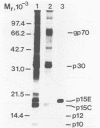Abstract
Synthetic peptides containing portions of a highly conserved region of retroviral transmembrane proteins of human and animal retroviruses were tested for their ability to inhibit lymphoproliferation to determine the minimum amino acid sequence required. The previously reported immunosuppression mediated by the peptide CKS-17 was confirmed and further localized to a sequence of eight residues essentially identical to the sequence present in the transmembrane protein gp21 of human T-lymphotropic virus types I and II (HTLV-I and -II). To substantiate the physiological relevance of the inhibition of lymphoproliferation observed with the synthetic peptides and to relate this activity to the intact protein, we purified the Rauscher murine leukemia virus transmembrane protein p15E by immunoaffinity chromatography and report that this purified component presented in the form of protein micelles inhibited the interleukin-2-dependent proliferation of the murine T-cell line CTLL-2 in a dose-dependent manner, with a half-maximal inhibitory dose (ID50) of approximately 16 nM. In comparison, the ID50 concentration of a recombinant form of p15E required to inhibit lymphoproliferation was approximately 2.2 microM. The results reported here support the hypothesis that the transmembrane protein gp21 of HTLV-I and -II participates in the mechanism of immunosuppression previously reported for the transmembrane proteins of feline leukemia virus and other animal retroviruses. Thus, the transmembrane protein of HTLV-I, the etiological agent of adult T-cell leukemia-lymphoma, may be partially responsible for the immunocompromised clinical course of this disease that results in fatal opportunistic infections in a majority of cases.
Full text
PDF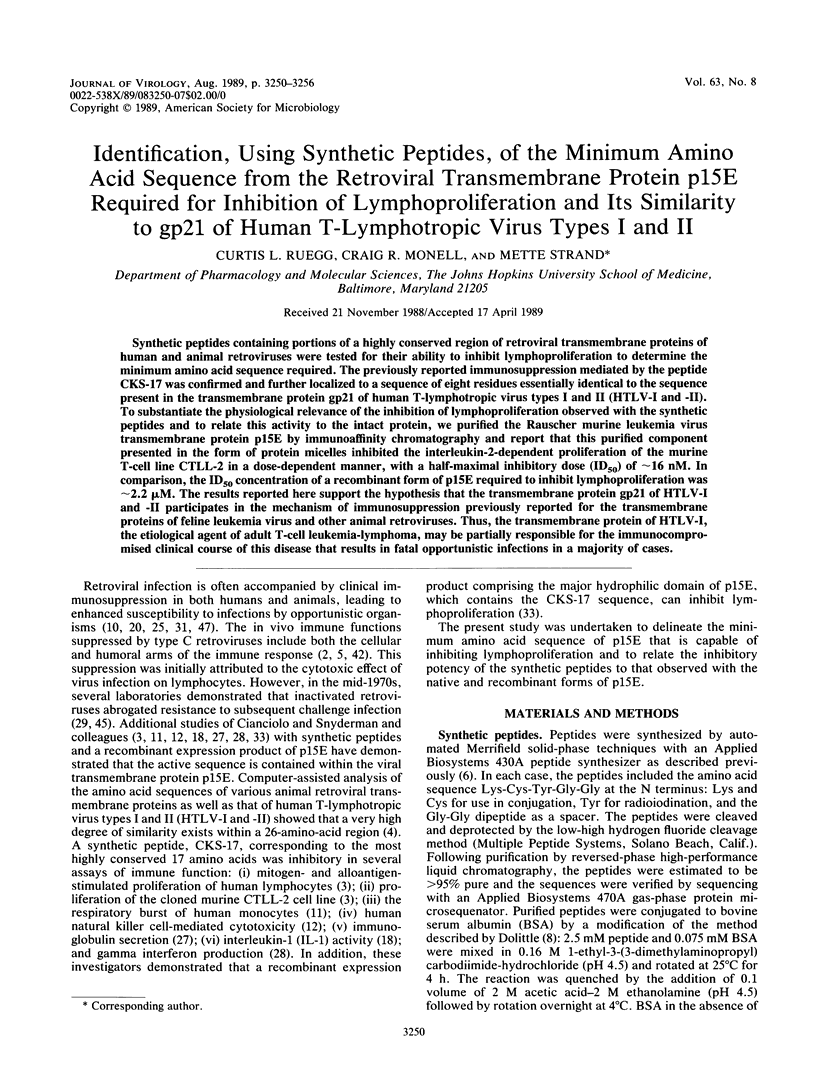
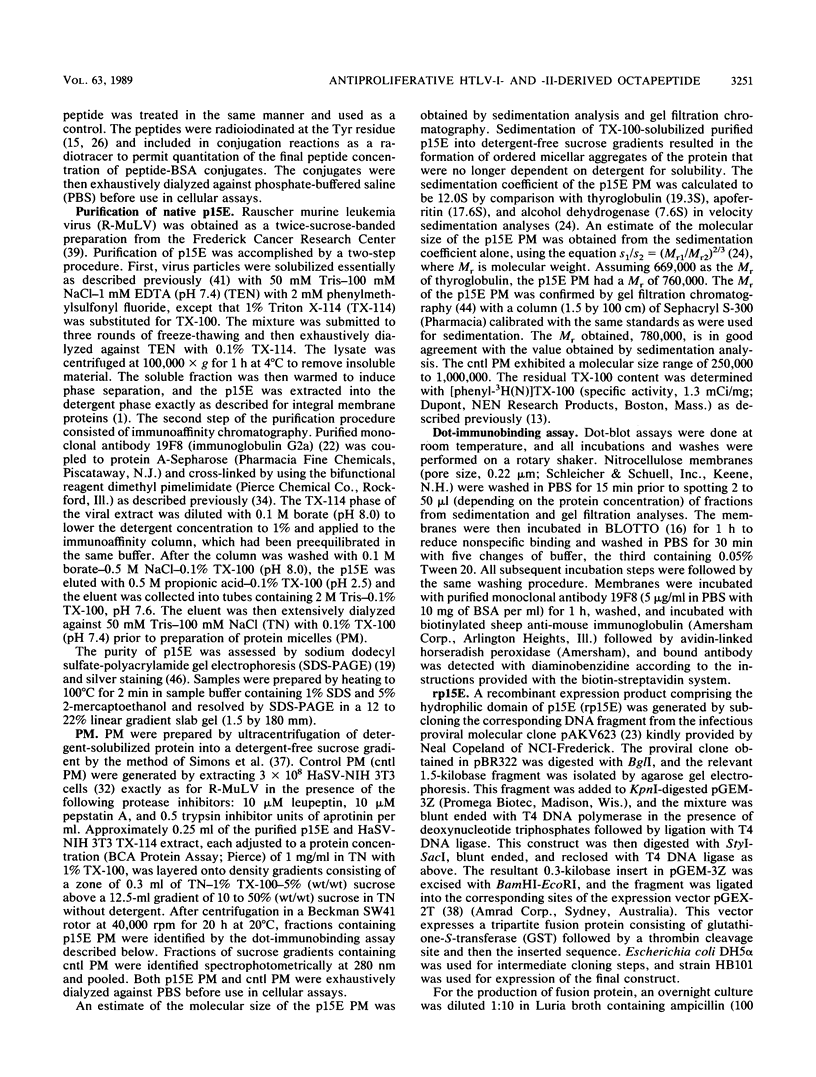


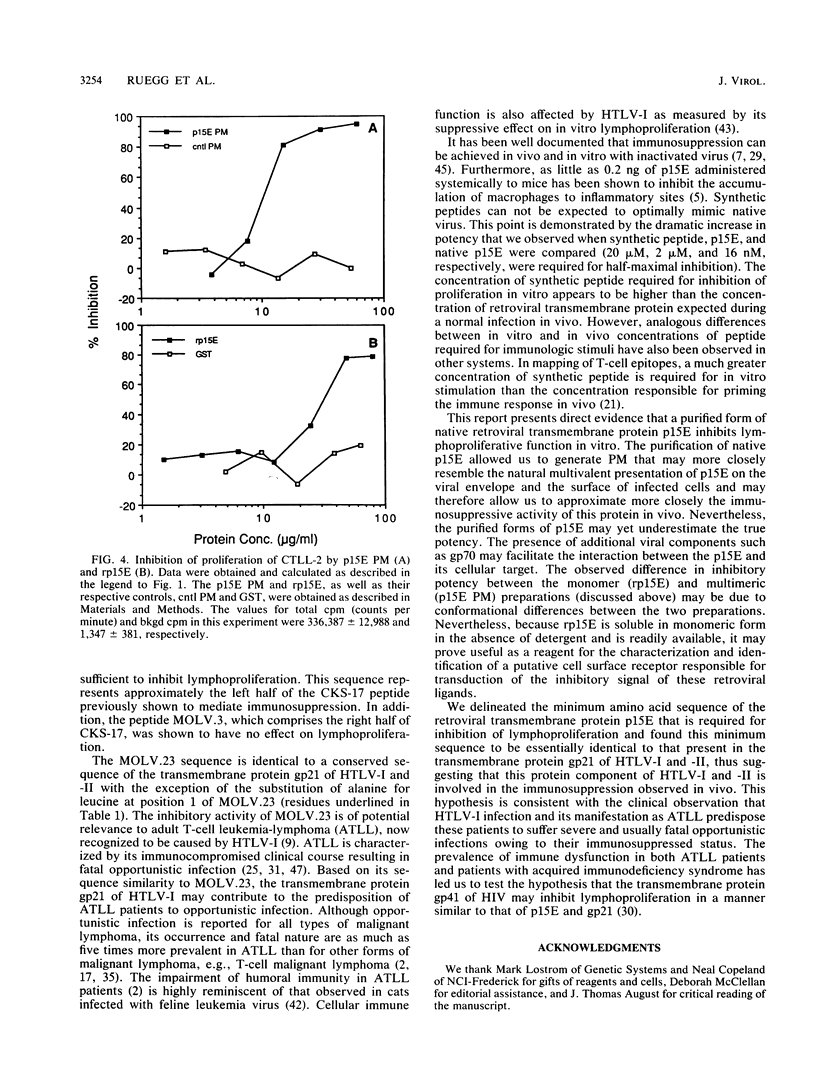
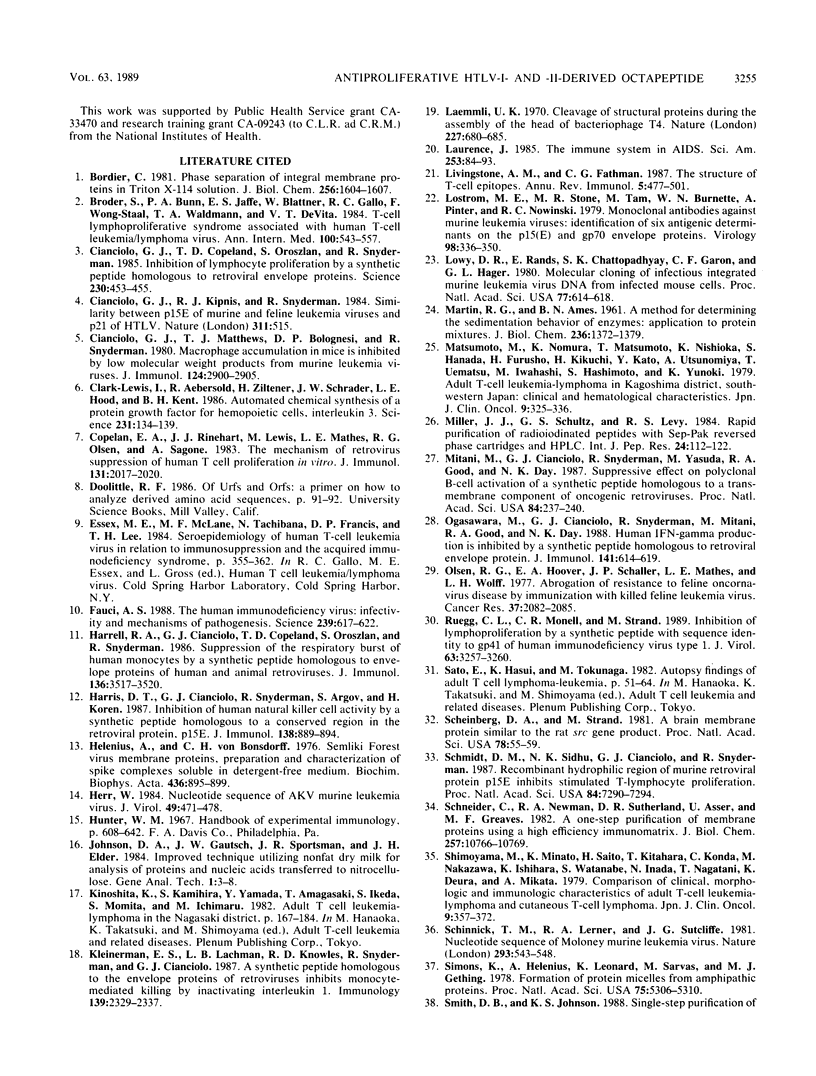
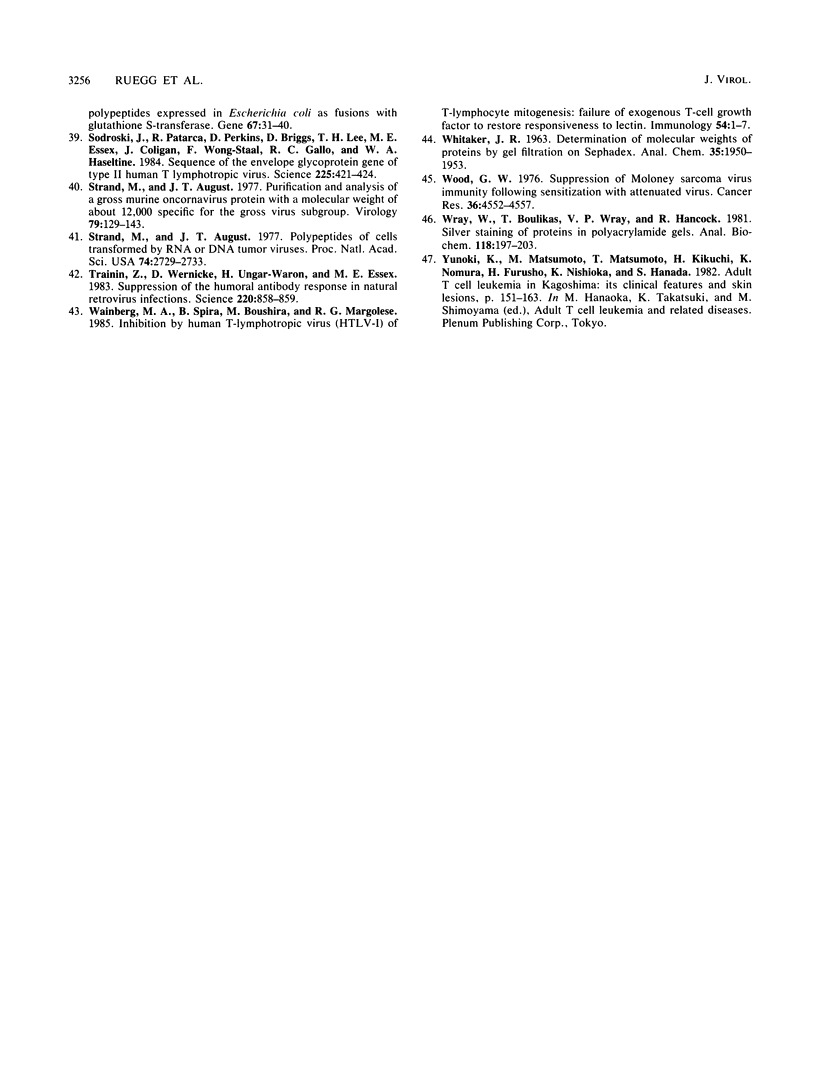
Images in this article
Selected References
These references are in PubMed. This may not be the complete list of references from this article.
- Bordier C. Phase separation of integral membrane proteins in Triton X-114 solution. J Biol Chem. 1981 Feb 25;256(4):1604–1607. [PubMed] [Google Scholar]
- Broder S., Bunn P. A., Jr, Jaffe E. S., Blattner W., Gallo R. C., Wong-Staal F., Waldmann T. A., DeVita V. T., Jr NIH conference. T-cell lymphoproliferative syndrome associated with human T-cell leukemia/lymphoma virus. Ann Intern Med. 1984 Apr;100(4):543–557. doi: 10.7326/0003-4819-100-4-543. [DOI] [PubMed] [Google Scholar]
- Cianciolo G. J., Copeland T. D., Oroszlan S., Snyderman R. Inhibition of lymphocyte proliferation by a synthetic peptide homologous to retroviral envelope proteins. Science. 1985 Oct 25;230(4724):453–455. doi: 10.1126/science.2996136. [DOI] [PubMed] [Google Scholar]
- Cianciolo G. J., Kipnis R. J., Snyderman R. Similarity between p15E of murine and feline leukaemia viruses and p21 of HTLV. Nature. 1984 Oct 11;311(5986):515–515. doi: 10.1038/311515a0. [DOI] [PubMed] [Google Scholar]
- Cianciolo G. J., Matthews T. J., Bolognesi D. P., Snyderman R. Macrophage accumulation in mice is inhibited by low molecular weight products from murine leukemia viruses. J Immunol. 1980 Jun;124(6):2900–2905. [PubMed] [Google Scholar]
- Clark-Lewis I., Aebersold R., Ziltener H., Schrader J. W., Hood L. E., Kent S. B. Automated chemical synthesis of a protein growth factor for hemopoietic cells, interleukin-3. Science. 1986 Jan 10;231(4734):134–139. doi: 10.1126/science.3079915. [DOI] [PubMed] [Google Scholar]
- Copelan E. A., Rinehart J. J., Lewis M., Mathes L., Olsen R., Sagone A. The mechanism of retrovirus suppression of human T cell proliferation in vitro. J Immunol. 1983 Oct;131(4):2017–2020. [PubMed] [Google Scholar]
- Fauci A. S. The human immunodeficiency virus: infectivity and mechanisms of pathogenesis. Science. 1988 Feb 5;239(4840):617–622. doi: 10.1126/science.3277274. [DOI] [PubMed] [Google Scholar]
- Harrell R. A., Cianciolo G. J., Copeland T. D., Oroszlan S., Snyderman R. Suppression of the respiratory burst of human monocytes by a synthetic peptide homologous to envelope proteins of human and animal retroviruses. J Immunol. 1986 May 15;136(10):3517–3520. [PubMed] [Google Scholar]
- Harris D. T., Cianciolo G. J., Snyderman R., Argov S., Koren H. S. Inhibition of human natural killer cell activity by a synthetic peptide homologous to a conserved region in the retroviral protein, p15E. J Immunol. 1987 Feb 1;138(3):889–894. [PubMed] [Google Scholar]
- Helenius A., von Bonsdorff C. H. Semlike Forest virus membrane proteins. Preparation and characterization of spike complexes soluble in detergent-free medium. Biochim Biophys Acta. 1976 Jul 15;436(4):895–899. doi: 10.1016/0005-2736(76)90421-1. [DOI] [PubMed] [Google Scholar]
- Herr W. Nucleotide sequence of AKV murine leukemia virus. J Virol. 1984 Feb;49(2):471–478. doi: 10.1128/jvi.49.2.471-478.1984. [DOI] [PMC free article] [PubMed] [Google Scholar]
- Kleinerman E. S., Lachman L. B., Knowles R. D., Snyderman R., Cianciolo G. J. A synthetic peptide homologous to the envelope proteins of retroviruses inhibits monocyte-mediated killing by inactivating interleukin 1. J Immunol. 1987 Oct 1;139(7):2329–2337. [PubMed] [Google Scholar]
- Laemmli U. K. Cleavage of structural proteins during the assembly of the head of bacteriophage T4. Nature. 1970 Aug 15;227(5259):680–685. doi: 10.1038/227680a0. [DOI] [PubMed] [Google Scholar]
- Laurence J. The immune system in AIDS. Sci Am. 1985 Dec;253(6):84–93. doi: 10.1038/scientificamerican1285-84. [DOI] [PubMed] [Google Scholar]
- Livingstone A. M., Fathman C. G. The structure of T-cell epitopes. Annu Rev Immunol. 1987;5:477–501. doi: 10.1146/annurev.iy.05.040187.002401. [DOI] [PubMed] [Google Scholar]
- Lostrom M. E., Stone M. R., Tam M., Burnette W. N., Pinter A., Nowinski R. C. Monoclonal antibodies against murine leukemia viruses: identification of six antigenic determinants on the p 15(E) and gp70 envelope proteins. Virology. 1979 Oct 30;98(2):336–350. doi: 10.1016/0042-6822(79)90557-9. [DOI] [PubMed] [Google Scholar]
- Lowy D. R., Rands E., Chattopadhyay S. K., Garon C. F., Hager G. L. Molecular cloning of infectious integrated murine leukemia virus DNA from infected mouse cells. Proc Natl Acad Sci U S A. 1980 Jan;77(1):614–618. doi: 10.1073/pnas.77.1.614. [DOI] [PMC free article] [PubMed] [Google Scholar]
- MARTIN R. G., AMES B. N. A method for determining the sedimentation behavior of enzymes: application to protein mixtures. J Biol Chem. 1961 May;236:1372–1379. [PubMed] [Google Scholar]
- Miller J. J., Schultz G. S., Levy R. S. Rapid purification of radioiodinated peptides with Sep-Pak reversed phase cartridges and HPLC. Int J Pept Protein Res. 1984 Aug;24(2):112–122. doi: 10.1111/j.1399-3011.1984.tb00935.x. [DOI] [PubMed] [Google Scholar]
- Mitani M., Cianciolo G. J., Snyderman R., Yasuda M., Good R. A., Day N. K. Suppressive effect on polyclonal B-cell activation of a synthetic peptide homologous to a transmembrane component of oncogenic retroviruses. Proc Natl Acad Sci U S A. 1987 Jan;84(1):237–240. doi: 10.1073/pnas.84.1.237. [DOI] [PMC free article] [PubMed] [Google Scholar]
- Ogasawara M., Cianciolo G. J., Snyderman R., Mitani M., Good R. A., Day N. K. Human IFN-gamma production is inhibited by a synthetic peptide homologous to retroviral envelope protein. J Immunol. 1988 Jul 15;141(2):614–619. [PubMed] [Google Scholar]
- Olsen R. G., Hoover E. A., Schaller J. P., Mathes L. E., Wolff L. H. Abrogation of resistance to feline oncornavirus disease by immunization with killed feline leukemia virus. Cancer Res. 1977 Jul;37(7 Pt 1):2082–2085. [PubMed] [Google Scholar]
- Ruegg C. L., Monell C. R., Strand M. Inhibition of lymphoproliferation by a synthetic peptide with sequence identity to gp41 of human immunodeficiency virus type 1. J Virol. 1989 Aug;63(8):3257–3260. doi: 10.1128/jvi.63.8.3257-3260.1989. [DOI] [PMC free article] [PubMed] [Google Scholar]
- Scheinberg D. A., Strand M. A brain membrane protein similar to the rat src gene product. Proc Natl Acad Sci U S A. 1981 Jan;78(1):55–59. doi: 10.1073/pnas.78.1.55. [DOI] [PMC free article] [PubMed] [Google Scholar]
- Schmidt D. M., Sidhu N. K., Cianciolo G. J., Snyderman R. Recombinant hydrophilic region of murine retroviral protein p15E inhibits stimulated T-lymphocyte proliferation. Proc Natl Acad Sci U S A. 1987 Oct;84(20):7290–7294. doi: 10.1073/pnas.84.20.7290. [DOI] [PMC free article] [PubMed] [Google Scholar]
- Schneider C., Newman R. A., Sutherland D. R., Asser U., Greaves M. F. A one-step purification of membrane proteins using a high efficiency immunomatrix. J Biol Chem. 1982 Sep 25;257(18):10766–10769. [PubMed] [Google Scholar]
- Shinnick T. M., Lerner R. A., Sutcliffe J. G. Nucleotide sequence of Moloney murine leukaemia virus. Nature. 1981 Oct 15;293(5833):543–548. doi: 10.1038/293543a0. [DOI] [PubMed] [Google Scholar]
- Simons K., Helenius A., Leonard K., Sarvas M., Gething M. J. Formation of protein micelles from amphiphilic membrane proteins. Proc Natl Acad Sci U S A. 1978 Nov;75(11):5306–5310. doi: 10.1073/pnas.75.11.5306. [DOI] [PMC free article] [PubMed] [Google Scholar]
- Sodroski J., Patarca R., Perkins D., Briggs D., Lee T. H., Essex M., Coligan J., Wong-Staal F., Gallo R. C., Haseltine W. A. Sequence of the envelope glycoprotein gene of type II human T lymphotropic virus. Science. 1984 Jul 27;225(4660):421–424. doi: 10.1126/science.6204380. [DOI] [PubMed] [Google Scholar]
- Strand M., August J. T. Polypeptides of cells transformed by RNA or DNA tumor viruses. Proc Natl Acad Sci U S A. 1977 Jul;74(7):2729–2733. doi: 10.1073/pnas.74.7.2729. [DOI] [PMC free article] [PubMed] [Google Scholar]
- Strand M., August J. T. Purification and analysis of a Gross murine oncornavirus protein with a molecular weight of about 12,000 specific for the Gross virus subgroup. Virology. 1977 Jun 1;79(1):129–143. doi: 10.1016/0042-6822(77)90340-3. [DOI] [PubMed] [Google Scholar]
- Trainin Z., Wernicke D., Ungar-Waron H., Essex M. Suppression of the humoral antibody response in natural retrovirus infections. Science. 1983 May 20;220(4599):858–859. doi: 10.1126/science.6302837. [DOI] [PubMed] [Google Scholar]
- Wainberg M. A., Spira B., Boushira M., Margolese R. G. Inhibition by human T-lymphotropic virus (HTLV-I) of T-lymphocyte mitogenesis: failure of exogenous T-cell growth factor to restore responsiveness to lectin. Immunology. 1985 Jan;54(1):1–7. [PMC free article] [PubMed] [Google Scholar]
- Wood G. W. Suppression of Moloney sarcoma virus immunity following sensitization with attenuated virus. Cancer Res. 1976 Dec;36(12):4552–4557. [PubMed] [Google Scholar]
- Wray W., Boulikas T., Wray V. P., Hancock R. Silver staining of proteins in polyacrylamide gels. Anal Biochem. 1981 Nov 15;118(1):197–203. doi: 10.1016/0003-2697(81)90179-2. [DOI] [PubMed] [Google Scholar]



